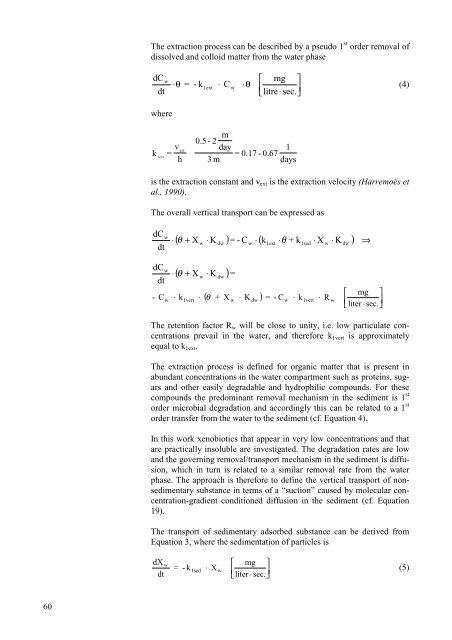Phthalates and Nonylphenols in Roskilde Fjord
Phthalates and Nonylphenols in Roskilde Fjord
Phthalates and Nonylphenols in Roskilde Fjord
You also want an ePaper? Increase the reach of your titles
YUMPU automatically turns print PDFs into web optimized ePapers that Google loves.
The extraction process can be described by a pseudo 1 st order removal ofdissolved <strong>and</strong> colloid matter from the water phasedCdtw⋅ θ=- k1ext⋅Cw⋅θ⎡ mg ⎤⎢ ⎥⎣litre⋅ sec. ⎦(4)wherek1extv=hext0.5 - 23 mmday= 0.17 - 0.671daysis the extraction constant <strong>and</strong> v ext is the extraction velocity (Harremoës etal., 1990).The overall vertical transport can be expressed asdCdtw⋅( θ + X ⋅ K ) = - C ⋅ ( k ⋅θ+ k ⋅ X ⋅ K ) ⇒wdww1ext1sedwdwdCdtw⋅ ( θ + X ⋅ K )=wdwmg⎢⎣liter⋅sec.⎡ ⎤( θ + X ⋅ K ) = - C ⋅ k ⋅ R⎥ ⎦- C w ⋅ k1vert⋅w dww 1vert wThe retention factor R w will be close to unity, i.e. low particulate concentrationsprevail <strong>in</strong> the water, <strong>and</strong> therefore k 1vert is approximatelyequal to k 1ext .The extraction process is def<strong>in</strong>ed for organic matter that is present <strong>in</strong>abundant concentrations <strong>in</strong> the water compartment such as prote<strong>in</strong>s, sugars<strong>and</strong> other easily degradable <strong>and</strong> hydrophilic compounds. For thesecompounds the predom<strong>in</strong>ant removal mechanism <strong>in</strong> the sediment is 1 storder microbial degradation <strong>and</strong> accord<strong>in</strong>gly this can be related to a 1 storder transfer from the water to the sediment (cf. Equation 4).In this work xenobiotics that appear <strong>in</strong> very low concentrations <strong>and</strong> thatare practically <strong>in</strong>soluble are <strong>in</strong>vestigated. The degradation rates are low<strong>and</strong> the govern<strong>in</strong>g removal/transport mechanism <strong>in</strong> the sediment is diffusion,which <strong>in</strong> turn is related to a similar removal rate from the waterphase. The approach is therefore to def<strong>in</strong>e the vertical transport of nonsedimentarysubstance <strong>in</strong> terms of a “suction” caused by molecular concentration-gradientconditioned diffusion <strong>in</strong> the sediment (cf. Equation19).The transport of sedimentary adsorbed substance can be derived fromEquation 3, where the sedimentation of particles isdXdtw=- k1sed⋅Xw⎡ mg ⎤⎢ ⎥⎣liter⋅ sec. ⎦(5)60
















